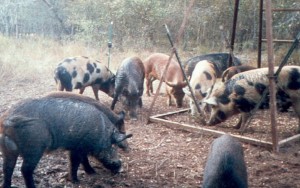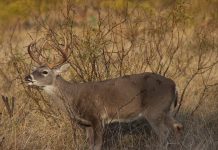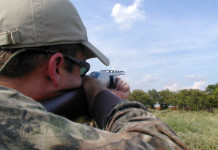The old joke goes something like this: “If a feral hog sow produces a dozen piglets, 13 survive.”
However, no one’s laughing, certainly not farmers and landowners whose crops and fields prime for rooting continually are devastated by a growing menace.
It’s no secret that feral hogs have had a detrimental impact across Texas for years, but there has been no hard data about what the future holds for the four-legged scourge.
Until now.
A Texas A&M University report compiled by scientists and biologists doesn’t attempt to pinpoint the exact number of hogs in the state, but rather highlight suitable habitat and attributes related to the growing population for historical estimation purposes.
The findings are startling, predicting a massive rise in the population without proper control in a state featuring more places for the swine to call home than most people may realize. The bottom line is this, according to the study: if left unchecked, the state’s feral hog tally – which was averaged at roughly 2.6 million animals – will more than triple in five years.
Using landowner surveys in 2010 from 139 of Texas’ 254 counties, the report found that the estimated reduction on feral hogs statewide from trapping, hunting and other methods was 753,646, or 29 percent of the population. Even at that same harvest rate, the report states that the population would still double in five years.
The most glaring figure from the report is the reduction rate necessary to keep the population in check. Roughly 66 percent of the animals must be taken off the range annually to keep their ranks from growing – something that’s never going to happen by any means or methods.
The analysis also showed that nearly 80 percent of Texas – approximately 134 million acres – is suitable feral hog habitat. If you’re reading this, the odds are pretty good there’s a feral hog – or 10 – within a square mile.
The report also relied on nearly two dozen other scientific studies to show just how quickly and how prolific feral hogs can reproduce. The invasive species, which has the highest reproductive rate of any hoofed animal, hits reproductive maturity at roughly eight months on average, according to those studies, and produces an average of 1½ litters each year. Those litters may only have an average of four to six piglets, according to Texas Parks and Wildlife Department biologists, but it’s not uncommon for them to have twice that many.
Simply put, feral hogs are here to stay, and they can live and even thrive in places other critters can’t.
The main concern from the rise in hog numbers is the damage they cause, specifically as a result of rooting and trampling that makes those associated areas unsuitable for crop production or livestock grazing. Feral hogs also are a direct competitor for any forage they can reach, which even includes other wildlife such as ground-nesting birds and their eggs, biologists say.
Another concern cited by biologists is the possibility of diseases being spread to livestock and other wildlife. Though the diseases from feral hogs don’t pose a significant threat to humans, the notable illnesses documented in feral hog populations include swine brucellosis, tuberculosis, bubonic plague and anthrax. Feral hogs also are known to harbor a variety of external parasites, including ticks and fleas, which also can carry diseases.
House Bill 716, which was signed into law and went into effect in September 2011, prohibits the Parks and Wildlife Commission from adopting regulations prohibiting a landowner or their agent from contracting or agreeing to participate as a hunter or observer in using a helicopter to shoot feral hogs or coyotes. The only change under the legislation from the previous version of the law is that TPWD is not allowed to prohibit a landowner or someone they designate as their “agent” from aerial gunning.
This means that landowners theoretically can turn a profit by charging people to shoot hogs. There’s no doubt that feral hogs are a scourge on the entire landscape, and while aerial gunning is one of the best ways to try and control the state swine population, the impact of the legislation will be unknown for years — and possibly never.
The key point remains that aerial gunning is considered hunting and as such allows TPWD oversight, but in truth it simply is commercial shooting, and while it opens the door literally and figuratively to what could slow the growth of feral swine, only time will tell if it has any real impact. The state issued about 100 permits for pork chopping previously and I’m not convinced that number significantly will rise even as the hog population rises. It certainly won’t grow at the same pace.
Most places charge about $100 a hog if you come out and sit near a feeder with your .270, but I’m certain few of those same people would be willing to shell out $500 to $1,000 to offset the costs associated with doing the same thing in a helicopter, which adds a variety of other safety issues.
There are a number of companies that specialize in aerial gunning for hogs in Texas, but to say that the pursuit is hunting simply isn’t true. Many outings result simply in hogs being shot and killed or wounded and left to die.





















